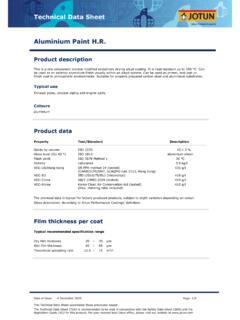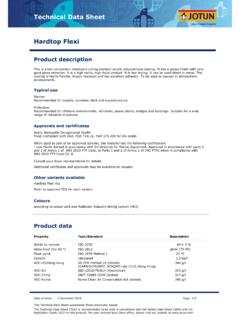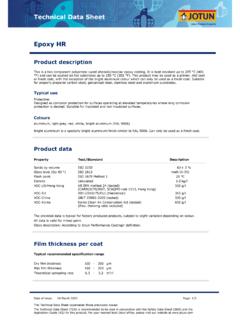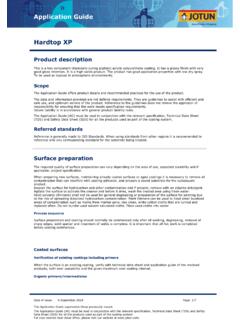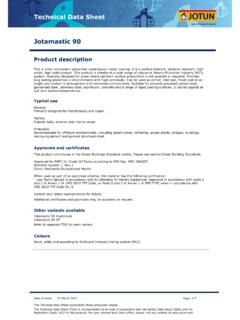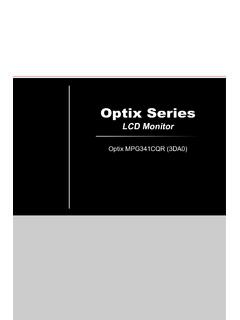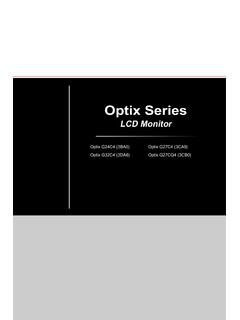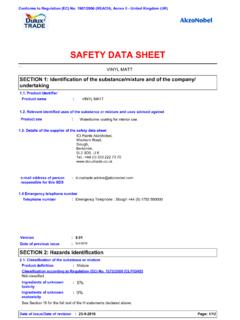Transcription of SAFETY DATA SHEET - Jotun
1 Jotun Thinner No. 10 Not nameOther means of identificationProduct typeEmergency telephone numberSection 1. Identification::::Supplier's details: Jotun Thinner No. 10 SAFETY DATA SHEETP roduct codeProduct description:Solvent.:5495491,2549^(Valid ationDate)1 Jotun AS, Norway+47 33 45 70 00 Jotun UAE Ltd. 3671, Dubai, : 009714 3395000 Fax:009714 3380666 Jotun Abu Dhabi Dhabi : 00971 2 5510300 Fax:00971 2 to UN GHS ( ) (2017)Section 2. Hazards identificationFLAMMABLE LIQUIDS - Category 3 ACUTE TOXICITY (dermal) - Category 4 SKIN CORROSION/IRRITATION - Category 2 SERIOUS EYE DAMAGE/EYE IRRITATION - Category 2 ASPECIFIC TARGET ORGAN TOXICITY - SINGLE EXPOSURE (Respiratory tract irritation) - Category 3 SPECIFIC TARGET ORGAN TOXICITY - REPEATED EXPOSURE - Category 2 ASPIRATION HAZARD - Category 1 LONG-TERM (CHRONIC) AQUATIC HAZARD - Category 3 Classification of the substance or mixture:Signal statements:H226 - Flammable liquid and - May be fatal if swallowed and enters - Harmful in contact with - Causes skin - Causes serious eye - May cause respiratory - May cause damage to organs through prolonged or repeated exposure.
2 (hearing organs)Hazard pictograms:GHS label elementsDate of issue/Date of of previous Thinner No. 10 Section 2. Hazards identificationH412 - Harmful to aquatic life with long lasting statementsPrevention:P280 - Wear protective gloves and protective clothing. Wear eye or face - Keep away from heat, hot surfaces, sparks, open flames and other ignition sources. No - Use only outdoors or in a well-ventilated - Avoid release to the - Do not breathe vapour or - Wash hands thoroughly after :P304 + P312 - IF INHALED: Call a POISON CENTER or doctor if you feel + P310, P331 - IF SWALLOWED: Immediately call a POISON CENTER or doctor. Do NOT induce + P364 - Take off contaminated clothing and wash it before + P312 - IF ON SKIN: Call a POISON CENTER or doctor if you feel + P351 + P338 - IF IN EYES: Rinse cautiously with water for several contact lenses, if present and easy to do.
3 Continue + P313 - If eye irritation persists: Get medical advice or :P405 - Store locked + P233 - Store in a well-ventilated place. Keep container tightly :P501 - Dispose of contents and container in accordance with all local, regional,national and international hazards which do not result in classification:None :P102 - Keep out of reach of 3. Composition/information on ingredientsxylene 50 - 721330-20-7ethylbenzene 10 - 24100-41-4n-butyl acetate 10 - <20123-86-4 Ingredient nameCAS number%There are no additional ingredients present which, within the current knowledge of the supplier and in the concentrations applicable, are classified as hazardous to health or the environment and hence require reporting in this means of identification:Not number:Not code:549 CAS number/other identifiersEC number:Mixture.:Occupational exposure limits, if available, are listed in Section flush eyes with plenty of water, occasionally lifting the upper and lower eyelids.
4 Check for and remove any contact lenses. Continue to rinse for at least 10 minutes. Get medical 4. First aid measuresEye contact:Description of necessary first aid measuresDate of issue/Date of of previous Thinner No. 10 Section 4. First aid measuresGet medical attention immediately. Call a poison center or physician. Wash out mouth with water. Remove dentures if any. If material has been swallowed and the exposed person is conscious, give small quantities of water to drink. Stop if the exposed person feels sick as vomiting may be dangerous. Aspiration hazard if swallowed. Can enter lungs and cause damage. Do not induce vomiting. If vomiting occurs, the head should be kept low so that vomit does not enter the give anything by mouth to an unconscious person. If unconscious, place in recovery position and get medical attention immediately. Maintain an open tight clothing such as a collar, tie, belt or with plenty of soap and water.
5 Remove contaminated clothing and contaminated clothing thoroughly with water before removing it, or wear gloves. Continue to rinse for at least 10 minutes. Get medical attention. If necessary, call a poison center or physician. Wash clothing before reuse. Clean shoes thoroughly before victim to fresh air and keep at rest in a position comfortable for it is suspected that fumes are still present, the rescuer should wear an appropriate mask or self-contained breathing apparatus. If not breathing, if breathing is irregular or if respiratory arrest occurs, provide artificial respiration or oxygen by trained personnel. It may be dangerous to the person providing aid to give mouth-to-mouth resuscitation. Get medical attention. If necessary, call a poison center or unconscious, place in recovery position and get medical attention an open airway. Loosen tight clothing such as a collar, tie, belt or contactInhalationIngestion:::Protection of first-aiders:No action shall be taken involving any personal risk or without suitable training.
6 If it is suspected that fumes are still present, the rescuer should wear an appropriate mask or self-contained breathing apparatus. It may be dangerous to the person providing aid to give mouth-to-mouth resuscitation. Wash contaminated clothing thoroughly with water before removing it, or wear to physician:Treat symptomatically. Contact poison treatment specialist immediately if large quantities have been ingested or treatments:No specific important symptoms/effects, acute and delayedInhalation:May cause respiratory be fatal if swallowed and enters airways.:IngestionSkin contact:Harmful in contact with skin. Causes skin serious eye irritation.:Eye contactOver-exposure signs/symptomsSkin contactIngestionInhalationAdverse symptoms may include the following:respiratory tract irritationcoughingAdverse symptoms may include the following:nausea or vomitingAdverse symptoms may include the following:irritationredness:::Eye contact:Adverse symptoms may include the following:pain or irritationwateringrednessPotential acute health effectsSee toxicological information (Section 11)Indication of immediate medical attention and special treatment needed, if necessaryDate of issue/Date of of previous Thinner No.
7 10 Section 5. Firefighting measuresPromptly isolate the scene by removing all persons from the vicinity of the incident if there is a fire. No action shall be taken involving any personal risk or without suitable training. Move containers from fire area if this can be done without water spray to keep fire-exposed containers thermal decomposition productsSpecific hazards arising from the chemicalDecomposition products may include the following materials:carbon dioxidecarbon monoxideFlammable liquid and vapour. Runoff to sewer may create fire or explosion a fire or if heated, a pressure increase will occur and the container may burst, with the risk of a subsequent explosion. This material is harmful to aquatic life with long lasting effects. Fire water contaminated with this material must be contained and prevented from being discharged to any waterway, sewer or should wear appropriate protective equipment and self-contained breathing apparatus (SCBA) with a full face-piece operated in positive pressure protective equipment for fire-fightersUse dry chemical, CO , water spray (fog) or media:::Do not use water extinguishing media:Unsuitable extinguishing media:Special protective actions for fire-fighters:Section 6.
8 Accidental release measuresEnvironmental precautionsPersonal precautions, protective equipment and emergency proceduresStop leak if without risk. Move containers from spill area. Use spark-proof tools and explosion-proof equipment. Approach the release from upwind. Prevent entry into sewers, water courses, basements or confined areas. Wash spillages into an effluent treatment plant or proceed as follows. Contain and collect spillage with non-combustible, absorbent material sand, earth, vermiculite or diatomaceous earth and place in container for disposal according to local regulations (see Section 13).Dispose of via a licensed waste disposal contractor. Contaminated absorbent material may pose the same hazard as the spilt product. Note: see Section 1 for emergency contact information and Section 13 for waste disposal.::No action shall be taken involving any personal risk or without suitable surrounding areas.
9 Keep unnecessary and unprotected personnel from entering. Do not touch or walk through spilt material. Shut off all ignition flares, smoking or flames in hazard area. Avoid breathing vapour or adequate ventilation. Wear appropriate respirator when ventilation is inadequate. Put on appropriate personal protective dispersal of spilt material and runoff and contact with soil, waterways, drains and sewers. Inform the relevant authorities if the product has caused environmental pollution (sewers, waterways, soil or air). Water polluting material. May be harmful to the environment if released in large spill:Stop leak if without risk. Move containers from spill area. Use spark-proof tools and explosion-proof equipment. Dilute with water and mop up if , or if water-insoluble, absorb with an inert dry material and place in an appropriate waste disposal container.
10 Dispose of via a licensed waste disposal spill:Methods and material for containment and cleaning upFor non-emergency personnelFor emergency responders:If specialised clothing is required to deal with the spillage, take note of any information in Section 8 on suitable and unsuitable materials. See also the information in "For non-emergency personnel".Date of issue/Date of of previous Thinner No. 10 Section 7. Handling and storageAdvice on general occupational hygieneConditions for safe storage,including any incompatibilitiesEating, drinking and smoking should be prohibited in areas where this material is handled, stored and processed. Workers should wash hands and face before eating, drinking and smoking. Remove contaminated clothing and protective equipment before entering eating areas. See also Section 8 for additional information on hygiene in accordance with local regulations .

